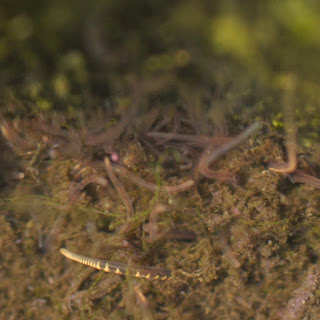The fourth post showing the progress of the frog tadpoles in my garden pond.
The changes this week have been much less dramatic. Their mouths seem to be bigger and stronger as they forage among the vegetation. They also vary hugely in size, even though they all seem to be at a similar stage of development and all came from the one clump of spawn.
They are also getting more difficult to photograph as they seem to prefer the murkier areas that are becoming choked with blanket weed. It doesn't seem to impede their progress, they just swim straight through it, and I think they are eating it, but they mostly nibble at the algae at the side of the pond or in the detritus at the bottom or on dead leaves.
A colony of tiny, worm-like animals attached to the side of the pond. They wave around constantly and vigorously and retract immediately when touched.
A kind of hydra?
Any information welcome.
A tadpole barging straight into them but the 'worms' didn't retract. If they are hydra they sting and feed on small invertebrates like daphnia.
Wolf spiders on the stones around the pond edge. This is a female, one of the Pardosa genus, probably monticola or palustris.
A male, you can just see the black palps between the front legs. I watched one yesterday displaying by raising and vibrating his palps to a seemingly entranced, if touchy, female - fascinating!







I've been looking for Hydra for years and never found them. There is a multi-headed species I believe. All species have a group of tentacles around a mouth or "stomach" with only the one entrance for food and also for voiding waste. The entrance to the sac will be surrounded by tentacles if you can see that Julian. A few of us at HSS (me and two others) agreed on a walk that we were taught in biology at school in great detail about Hydra, but were never given intructions how to go and observe them in the water! What kind of education is that?
ReplyDeleteinstructions I meant
ReplyDeleteI remember you mentioning hydra at one of the meetings, in fact that word was my starting point in finding out what these in my pond are. Trouble is that I can't find any illustrations of hydra on the Internet that look like these. Don't know what else they could be but I'll keep trying
ReplyDeleteI'd say they were a colony of roundworms. Hydra have a free body column that is visible and attached to aquatic vegetation rather than being in the sediment.
ReplyDeleteMy tadpoles have all seem to have been scoffed now although some were rescued early on and are thriving in a primary school aquarium.
Thanks Chris, I'll try to find some info on roundworms.
DeleteNewts eaten the tadpoles?
Yes I'm afraid so, although I always get two or three clumps of spawn so a few might make it to maturity.
DeleteOur tadpoles are doing ok here in Brighouse, like yours they are now less visible. The pond suffered from green algae in the warm weather, so we used a groundsheet supported by canes across the long narrowish pond to exclude all light for 3/4 days. When we took it off the water was almost clear and the tadpoles were active and feeding. Now that the rain has raised the water level we're hoping all will stay clear.
ReplyDeleteInteresting idea to use a groundsheet. I left more fallen leaves on the surface this year to exclude light. I also use an old hairbrush to fish out the blanketweed.
ReplyDelete